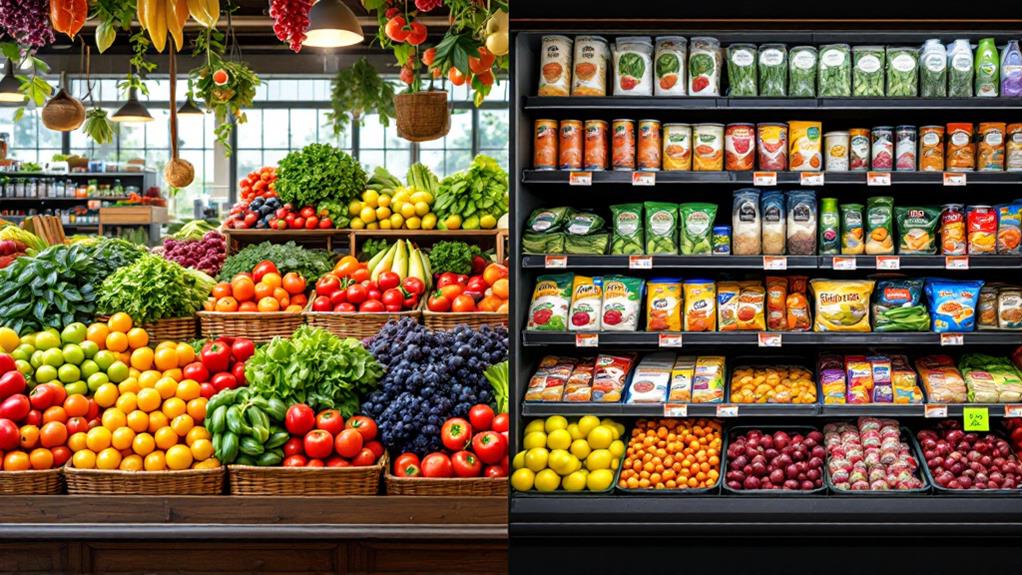Are Healthy Foods More Expensive? Debunking the Cost Myth

You might think healthy foods are expensive, but that's not always the case. Basic staples like carrots, lentils, and whole grains often cost less than processed items and offer more nutrition. Buying in bulk or choosing frozen and canned produce can cut costs considerably. By planning meals, you can avoid impulsive buys and stick to a budget. Even government guides show a nutritious diet is achievable for $167-$177 a month. Community initiatives improve access to affordable options too. If you investigate further, you'll find many ways to eat healthily without breaking the bank.
Understanding the Cost Myth
Many people believe that eating healthy is expensive, but this perception often stems from focusing on pricey specialty items like organic produce and trendy "superfoods." In reality, basic nutritious foods, such as carrots and lentils, are often cheaper than their processed counterparts. When you're exploring your food choices, it's essential to evaluate price comparisons between fresh produce and heavily processed items. You'll find that healthy foods can be budget-friendly.
For example, purchasing bulk items like lentils or opting for frozen produce can greatly lower costs. These choices allow you to enjoy nutritious meals without straining your wallet. The USDA Thrifty Food Plan even shows that healthy eating is possible on a modest monthly budget, suggesting you can eat well for as little as $167 to $177 per month.
Moreover, community initiatives and assistance programs, like farmers markets and WIC/SNAP benefits, can help you access healthy foods at reduced prices. These options make it easier for low-income households to choose nutritious foods without feeling the pinch. So, next time you're shopping, keep in mind that with smart price comparisons and thoughtful food choices, you can enjoy healthy eating without overspending.
Affordable Healthy Alternatives
While it's easy to get caught up in the misconception that healthy eating breaks the bank, there are plenty of affordable alternatives that challenge this myth. Consider staples like carrots, lentils, and potatoes. These healthy options often cost less than processed foods, making them a smart choice for your diet. By focusing on seasonal produce from local farmers markets, you can also find fresher and more affordable options compared to conventional grocery stores.
Don't overlook canned and frozen fruits and vegetables. They're not only nutritious but often cheaper than their fresh counterparts, helping you maintain a healthy diet without overspending. The USDA Thrifty Food Plan shows that a nutritious diet can be achieved for as little as $167-$177 per month for one adult, proving that affordability and health can go hand in hand.
Meal planning plays a vital role in sticking to a budget-friendly diet. By planning your meals and shopping with a list, you minimize food waste and keep grocery expenses in check. This approach not only supports a healthy lifestyle but also guarantees you're making the most of every dollar spent on nutritious foods.
Budget-Friendly Shopping Tips

Charting grocery shopping with a focus on budget-friendly choices doesn't have to be intimidating. Start by maintaining a grocery list based on what you already have at home. This simple step helps you avoid unnecessary purchases and stick to your budget. Planning ahead is key; use store flyers to guide your meal planning so you can capitalize on sales and create affordable meals. When you arrive at the store, make certain you're full. Shopping on an empty stomach often leads to impulse buys, especially unhealthy snacks or convenience foods.
Opt for in-store brands, which frequently offer high-quality alternatives at lower prices. This way, you can save money without compromising on nutrition. Eating healthy doesn't mean you have to buy everything organic. While organic produce can be pricier, some items are just as nutritious as fresh, conventional options and less expensive. Focus on whole grains and legumes, which are cost-effective and can be purchased in bulk. This not only reduces costs but also guarantees you've got a stash of long-lasting, nutritious ingredients. By incorporating these budget-friendly strategies, you'll find eating healthy is not just achievable, but also economical.
Value of Nutrient Density
Understanding nutrient density can transform your approach to eating well on a budget. It's all about choosing foods that pack a punch regarding nutrition relative to their calorie content. You might be surprised to learn that affordable foods like legumes and whole grains often surpass expensive processed items in nutrient density. These foods are rich in protein and fiber, crucial components of a healthy diet, without the hefty price tag.
Embracing plant-based diets can be both budget-friendly and health-enhancing. Fresh fruits and vegetables are nutrient powerhouses, but don't overlook canned produce, which retains high nutrient levels and often costs less. This makes them an excellent, wallet-friendly choice when fresh options are out of reach. Incorporating these into your home-cooked meals enhances your intake of vital nutrients without overspending.
Meal Planning for Savings

To improve the benefits of nutrient-dense foods without overspending, meal planning becomes your best ally. By planning your meals ahead, you can greatly reduce grocery expenses and avoid the temptation of expensive options. Start by incorporating seasonal produce into your meal planning, as these items are not only more nutritious but also typically more affordable. This approach guarantees you enjoy fresh, healthy foods without straining your budget.
Batch cooking is another effective strategy. By preparing meals in bulk, you can utilize versatile ingredients that prevent food waste and increase savings. Think of it as cooking once and eating multiple times, all while keeping costs down. Tracking your spending on groceries will help identify areas for improvement and encourage sticking to a budget-friendly meal plan.
Here's how you can make meal planning work for you:
- Plan ahead: Create weekly meal plans to avoid impulse buys.
- Use seasonal produce: Opt for fruits and vegetables in season to save money.
- Batch cook: Prepare meals in bulk to minimize food waste.
- Include staples: Incorporate affordable staples like lentils and beans for nutritious, budget-friendly meals.




